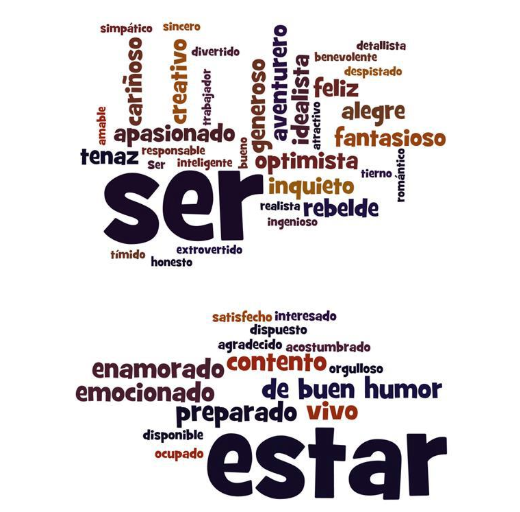In this lesson, we will show you the differences between ser and estar in Spanish. Both verbs can be translated as "to be" in English. So what are the differences and when to use them? Let's get right to it.
Ser and Estar are irregular verbs. If you don't know how to conjugate them, check out ser conjugation and estar conjugation charts.
 Ser vs Estar
Ser vs Estar
Ser vs Estar
In the table below, we cover all the main uses of ser and estar.
Ser vs Estar difference with table
| SER | ESTAR |
| Physical characteristics and personality | Temporarily physical states, emotions, or conditions |
Profession | Temporary job |
| Event location | Physical location |
| Price | Temporary or variable prices |
Date and time | Progressive tense |
| Possession |
|
| Origin and nationality |
|
| Identification |
SER
1. Physical characteristics and personality
El árbol es alto - The tree is tall.
Mi anillo es de oro. - My ring is made of gold.
La mesa es de madera. - The table is made of wood.
María es una persona muy alegre. - María is a happy person.
Ella es muy bonita. - She is very pretty.
Use ser to describe characteristics (height, size, shape, color, material) of an object or personality of a person. It's constant or permanent.
2. Origin and nationality
Soy Australiano / Soy de Australia. - I’m Australian / I’m from Australia.
Nosotros somos de NYC. - We are from NYC.
El arroz es de España. - The rice is from Spain.
Your nationality or your origin is a permannet characteristic. So when you want to describe your origin, use ser.
3. Profession
Él es carpintero. - He is a carpenter.
Soy un astronauta. I am an astronaut.
Ser is used to describe your profession, the occupation that you intend to devote yourself in the long term.
4. Event location
La boda fue en el campo. - The wedding was in the countryside.
El juego de fútbol es en el estadio. - The soccer game is in the Stadium.
Normally, estar is used when talking about location. However, if you are talking about events such as a wedding or a conference, use ser instead.
5. Date and time
Hoy es Jueves. - Today is Thursday.
Son las tres. - It’s three o’clock.
Ayer fue mi cumpleaños. - Yesterday was my birthday.
Ser is often used to talk about date and time.
Read this article if you want to learn about telling time in Spanish.
6. Possession
That pen is mine. - Ese bolígrafo es mío.
7. Identification
¡¿Qué es esto?! - What is that?!
Juana es mi jefe. - Juana is my boss.
Lynne es mi madre. - Lynne is my mother.
Ser can also be used when you want to identify an item or person. Personal relationships are also talked about using ser.
8. Price
¿Cuánto es? - How much is it?
Son €40 (cuarenta euros) - They are €40 (forty euros).
Use ser to ask or describe the price of an item.
ESTAR
1. Temporarily physical states, emotions, or conditions.
María está de buen humor. - María is in a good mood.
Mi novia está triste porque está demasiada ocupada. - My girlfriend is sad because she is too busy.
Estoy muy enojado - I am very angry.
Estoy tan cansada esta mañana. - I am so tired this morning.
Si estás cansado, te puedes acostar en el sofá. - If you're tired, you can lie down on the couch.
One's mood always changes throughout the day. You need to use estar to describe temporary states.
If you want to learn about common words to describe one's emotion, read this article: Emotions in Spanish.
Note: If something or someone is dead, you need to use the verb estar instead of ser to describe the physical state.
Mis abuelos están muertos. - My grandparents are dead.
2. Physical location
Ayer estuvimos en la playa. - Yesterday we were at the beach.
¿Dónde estás? - Where are you?
While ser is used to talk about an event location, estar is used to describe location of all other situations.
3. Temporary job
Estoy de camarero pero quiero ser abogado. - I’m a waiter but I want to be a lawyer.
Estoy de estudiante. - I’m a student.
To refer to a temporary work, use estar before the preposition "de".
4. Temporary or variable prices
La semana pasada naranjas estuvieron a dos dólares el kilo. - Last week oranges were two dollars per kilo.
¿A cuánto está el pulpo hoy? - How much is the octopus today?
Use estar before the preposition "a" when talking about prices that change on a daily basis in local market.
5. Progressive tense
Estoy buscando información sobre esta ciudad. - I’m looking for information about this city.
Estoy hablando con mi madre por teléfono. - I’m speaking with my mother on the phone.
So that's the difference between ser and estar. We hope that you will know when it is most appropriate to use each verb in Spanish.
